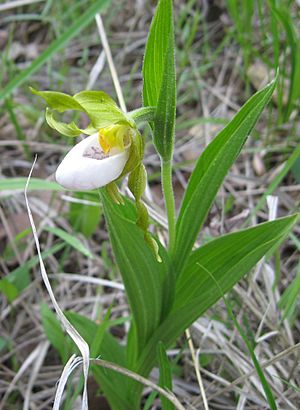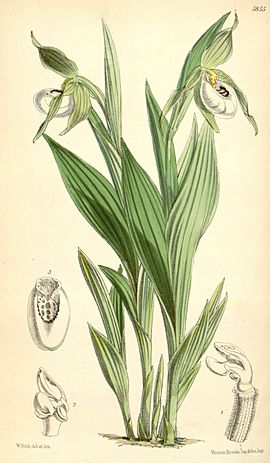Small white lady's slipper facts for kids
Quick facts for kids Small white lady's slipper |
|
|---|---|
 |
|
| Conservation status | |
| Scientific classification | |
| Genus: |
Cypripedium
|
| Species: |
candidum
|
| Synonyms | |
|
Calceolus candidus (Muhl. ex Willd.) Nieuwl. |
|
The Cypripedium candidum, also known as the small white lady's slipper, is a special and rare type of orchid. It belongs to the Cypripedium family. This beautiful flower grows naturally in eastern North America. You can find it in the northern parts of the United States and southern Canada.
Contents
Where Does This Orchid Live?
The small white lady's slipper grows in many places. It is found from western New York all the way to North Dakota. It also grows south to New Jersey and Missouri. There are also a few groups of these orchids in places like Connecticut, Maryland, Manitoba, Virginia, and Alabama. It used to grow in Saskatchewan, but it is not found there anymore.
This orchid likes to live in wet, swampy areas called fens. These places often have soil rich in calcium. You can also find them at the edges of sedge meadows and in ditches with lots of calcium.
What Does the Small White Lady's Slipper Look Like?
The Cypripedium candidum is one of the smallest orchids in North America. It usually grows to be about 20 to 36 centimeters (8 to 14 inches) tall. This orchid blooms in late May and early June.
Its most famous part is its white, pouch-like lip. This lip sometimes has small maroon dots inside. The side petals and sepals (leaf-like parts under the flower) are often tan, green, or brown.
Sometimes, this white orchid can mix with the small yellow lady's slipper. When they do, they create a natural mix called Cypripedium × andrewsii. The leaves and stems of the plant are a bit fuzzy. These plants often grow in large groups, and some groups can have 50 or more flowers!
The small white lady's slipper is a perennial plant. This means it lives for many years. It has roots that grow just a few centimeters under the ground. These roots help it survive most prairie fires.
Why Is This Orchid Special?
The small white lady's slipper is considered rare in Canada. It is even listed as endangered in Ontario. This means it is protected by law there. Sadly, it is thought to have disappeared from Saskatchewan. In Ontario, this orchid has always been uncommon. This is because there are not many fens (its favorite home) in southern Ontario. Now, it is only found in two places in Ontario.
In the United States, this orchid is also facing threats. It has disappeared from Pennsylvania. It is endangered in South Dakota, Wisconsin, Kentucky, and Michigan. It is rare in Missouri and North Dakota. However, in Illinois, it was once endangered but is now doing better. The Illinois Endangered Species Protection Board said it has "recovered" there.
Even though it's rare in some places, globally, it is considered "apparently secure." This is because there are protected areas for it across its entire range.
What Harms the Orchid?
Many things can cause the small white lady's slipper to decline. One big problem is losing its home. This happens when land is used for farming or building. Also, when natural fires are stopped, other plants can grow too much and crowd out the orchid.
Invasive plants are also a problem. These are plants that are not native and grow very fast. They can take over the orchid's space. Some examples are reed canary grass, dogwood, leafy spurge, St. John's wort, and buckthorn. Changes in water flow, fewer pollinators (like bees), and problems with tiny fungi (called mycorrhizae) that help the orchid grow also cause trouble.
Sometimes, the flowers are not pollinated, which means they don't produce many seeds. Small bees, like andrenid and halictid bees, help pollinate these flowers. They go into the flower's lip to drop off pollen and pick up more.
How Can We Help?
Many people have tried to dig up these wild orchids to grow them at home. But this often doesn't work and harms the wild plants. This orchid needs a lot of sunlight. So, to help it, people need to remove invasive plants and woody bushes that block the sun.
Scientists are watching this orchid closely. Programs like the Chicago Botanic Garden's Plants of Concern help monitor it. They found that more lady's slipper plants grow when controlled fires and brush removal are done. This shows that managing the land is very important for the orchid's survival.
See also
 In Spanish: Cypripedium candidum para niños
In Spanish: Cypripedium candidum para niños



